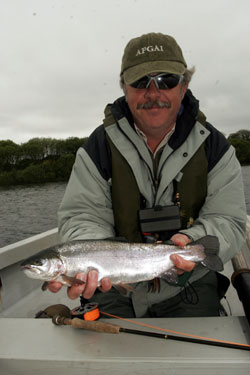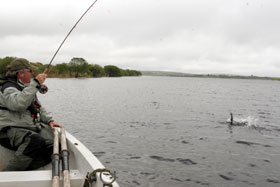Beetles, both aquatic and terrestrial, are often neglected by the fly fisherman and, considering that they are a main component of the trout’s diet, I think we are missing a trick. Here in the West Country, where we have fewer buzzers than in some parts of the country, beetle patterns can give us great sport.
I start to fish these patterns from the start of the season (March 15th), using them right until the end of the season.
There are more than 3,000 species of beetle in the UK, making them the largest group of insects we have. As well as the terrestrials (land-borne), there are more than 200 aquatic beetles. Looking at these numbers confirms that we, the fly fishermen, should have at least one or two imitations in our fly box! A lot of the terrestrials find their way onto the water either by falling or getting blown out of trees and bushes. Others just get blown onto the water because on the whole they are not the best fliers in the insect world. While fishing Stithians Lake a few years ago in a high wind, I caught one fish that when spooned gave up 13 varieties of terrestrial beetles.
A Bug’s Life
Some of the common terrestrial beetles that I find when spooning fish are leaf hoppers, ladybirds and rove beetles such as the devil’s
 |
coach-horse; the latter being the most common and found in abundance during late April through May and into June.
Late April and May sees the very large, annual ‘fall’ of hawthorn flies at Stithians, and arguably the best fishing of the year. However, careful inspection of the marrow spoon during sessions fishing hawthorn imitations will show just as many rove beetles as hawthorns – if not more. The true devil’s coach-horse is one of around 1,000 species of rove beetles found in Britain, so called because they are always on the move. They can fly but prefer to stay on the ground where they move around very quickly. They are easily recognised by their slender, mobile bodies that twist and turn in the water as well as on the land.
As for the aquatic beetles, most are of little interest to the fly fisherman as they tend to hide away in dense areas of weed. Although the fish might feed on them it would be almost impossible to fish an imitation effectively, and even if a fish were hooked it would almost certainly be lost. The exception to this is the whirligig beetle, so called because of the way that it spins around on the surface of the water in the latter end of the season. This beetle is imitated using the smaller sizes of our basic pattern because the naturals are rarely as large as a size 14.
Of more interest to us is the lesser water boatman or Corixa. Although technically not a beetle, one could be forgiven for thinking that it is, as its appearance is very similar. For our purpose that means only a slight adaptation to our basic beetle pattern.
Tying The Beetles: The Fab Four
After years of experimenting with patterns, I could not come up with one that I really believed would work well under all conditions. This was until I tried tying to hang one from the surface, and fish it like a dry fly. Therefore, the dressing for most of my beetle patterns is very simple; I use closed-cell foam for the back of most. I look for the profile of the fly and how it sits in the surface film of the water.
Although you can make your beetles more complicated by the addition of legs, antennae, eyes and the rest, why not use that time to go fishing and keep your flies simple? If you want to experiment a little more, tie the beetles in different colours. However, I believe that the shape and size are the most important elements. These imitations, like the natural, are sitting in or on the surface film of the water and, as such, will be seen more as a silhouette against the sky rather than the particular colour. Remember, most beetles are dark on the underside – I don’t believe that if you catch a fish full of ladybirds that a fly with a red back will be any more effective than our basic pattern.
 |
1. The Freddy
My favourite hook for all of the beetle patterns is a Kamasan B160 in sizes 10 to 16. For the basic pattern, affectionately know as the Freddy, cut a strip from a Veniards closed-cell foam sheet and tie it onto the shank of the hook with the foam extending to the rear. Dub the body using peacock-black Glister, and finish by bringing the foam over to form the back, tie down, whip and cut off the foam leaving a small section of foam to form a head over the eye of the hook – it’s very easy but very effective! The only adaptation I occasionally make is to include a small amount of Tiemco Aero as a sight indicator on the back of the fly. This pattern was used by my wife Annie while teaching a group from Truro’s Penair School; it accounted for more than 30 fish in the second week of July on Stithians!
 |
 |
 |
 |
 |
 |
 |
2. Champo’s Corixa
To tie the Corixa is a little more complicated. To start with I tie it in reverse, meaning that the head is towards the bend of the hook. I put a small wrap of lead under the head as we want the fly to hang down in the water, and I also include two rubber legs and occasionally put on a couple of eyes as well as a turn of pearl tinsel at the tail (ie the eye of the hook) to imitate the small bubble of air that is formed as the Corixa breathes. The trick with this fly is to get it to hang from the surface, so you may need to experiment with the amount of lead and a glass of water to get it right, and, again, you might want to fish it with a sight indicator.
 |
 |
 |
 |
3. Devil’s Coach-Horse
For the Devil’s Coach-Horse or rove beetle imitation, I tie the basic pattern but with a tail. By far the most effective tail is to place rabbit fur in a loop, spin it and then furl it. Furling is a method of twisting a product to a point where it will twist on itself. If you twist up an inch of rabbit fur and then fold it in half over a dubbing needle you will see it twist together. This forms your detached, furled body and, followed by a slight trim and tease, this gives a very mobile body/tail. A length of chenille with the end gently melted will suffice. This is the only one of the beetles that needs to be retrieved, preferably with a jerky figure-of-eight.
 |
 |
 |
 |
4. Epoxy Beetle
The other beetle imitation that I will always have in the box is an Epoxy Beetle tied with black thread and pheasant tail fibres. Tie a small bunch of pheasant tail fibres on the top of a size 16 B160 and then form the body shape you want with the thread, bringing the fibres over to form the back of the beetle, tying them in two-thirds of the way up the fly, then trim off and finish the head. Once tied, give the whole fly a coat of epoxy, nail varnish or, in my case, I now use Loon UV Knot Sense and a UV torch to cure it, as this method is less messy and faster.
 |
 |
 |
Fishing With The Beetles
Like the fly tying, fishing these patterns is very simple. I tend to fish them mostly static, maybe with the odd twitch in the case of the Corixa to bring the legs to life. One word of advice, though – you should never put your rod down with a fly in the water! To do so with these patterns could end up in disaster, because the takes are very confident and the fish nearly always hook themselves; I think this is due to the way the fly sits, lifelike in the surface film.
I will fish the Epoxy Beetle in the same way as a buzzer, either under a Freddy or as a ‘washing line’ with a Freddy on the point. Why not try an Epoxy Beetle in the middle of your own buzzer rig?
For me, the perfect day for fishing any of these flies, as with most fishing, is overcast with a good ripple on the water, blowing left to right or right to left along the bank (if it’s a strong wind, remember safety and keep the line downwind of yourself when casting). This causes the line to gently pull the flies around in a big arc, in the same way that you would fish a team of buzzers; hold on, because the takes will be very firm!
I have also had great results on those hot, sunny summer days that you think would be a waste of time. More than 50 youngsters each caught their first-ever fish using these flies while out with Annie and myself on summer schools days, and fishing between 10am and 3pm during July and August 2006; this, I think, speaks for itself!






